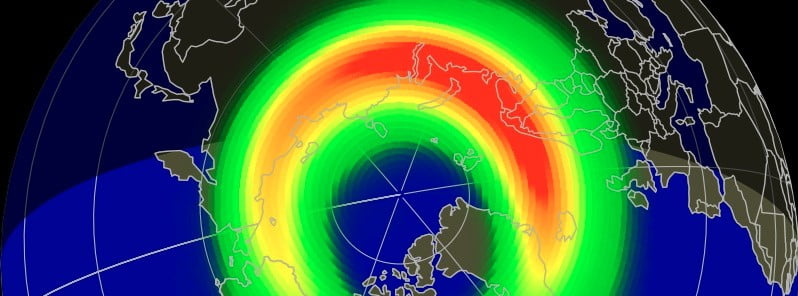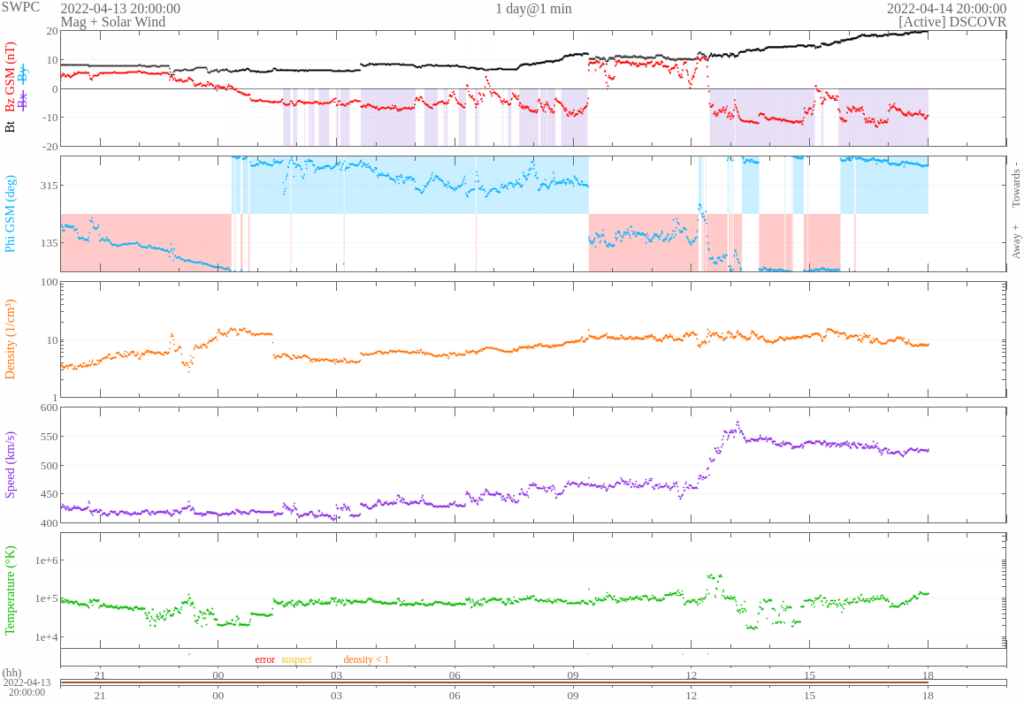CME hits Earth, sparking G2 – Moderate geomagnetic storm

A coronal mass ejection (CME) produced by a large filament eruption at 05:21 UTC on April 11, 2022 reached Earth around midnight UTC on April 14, sparking G2 – Moderate geomagnetic storm.
In 24 hours to 12:30 UTC on April 14, the solar wind environment sampled by the DSCOVR satellite showed continued influence from yesterday’s CME prior to the arrival of the April 11 full halo CME around midnight UTC on April 14.1
Total field strength peaked at 11 nT and the Bz component underwent numerous southward deviations after the arrival of this CME.
A maximum southward deviation of -8 nT was so far observed.
Wind speeds decreased to around 420 km/s, then increased again with today’s CME. Phi also switched from mostly positive to mostly negative with this CME.

The 2 MeV electron flux reached high levels with a peak flux of 1 420 pfu at 13:50 UTC on April 13 while the 10 MeV proton flux remained at background levels.
The 2 MeV electron flux is expected to be at low to moderate levels and the 10 MeV proton flux is expected to continue at background levels through April 16.
The geomagnetic field was at mostly quiet levels until the arrival of April 11.
Geomagnetic K-index of 4 threshold was reached at 06:54 UTC on April 14, followed by K-index of 5 (G1 – Minor geomagnetic storm) at 11:59 UTC and K-index of 6 (G2 – Moderate geomagnetic storm) at 16:30 UTC.
G2 geomagnetic storm potential impacts:
Area of impact primarily poleward of 55 degrees Geomagnetic Latitude.
Induced Currents – Power grid fluctuations can occur. High-latitude power systems may experience voltage alarms.
Spacecraft – Satellite orientation irregularities may occur; increased drag on low Earth-orbit satellites is possible.
Radio – HF (high frequency) radio propagation can fade at higher latitudes.
Aurora – Aurora may be seen as low as New York to Wisconsin to Washington state.
G1 – Minor geomagnetic storming is likely to persist into April 15 with ongoing effects from the CME, coupled with the arrival of a positive polarity coronal hole high speed stream (CH HSS).
Primarily unsettled to active periods are expected on April 16 under continued CH HSS effects.
In terms of solar flare activity, all the action is currently on the far side of the Sun produced by a large and complex sunspot region expected to turn into Earth view in about 5 days.
Reference:
1 Forecast Discussion issued: 2022 Apr 14 1230 UTC – Prepared by the U.S. Dept. of Commerce, NOAA, Space Weather Prediction Center
Featured image credit: NOAA/SWPC

Commenting rules and guidelines
We value the thoughts and opinions of our readers and welcome healthy discussions on our website. In order to maintain a respectful and positive community, we ask that all commenters follow these rules.